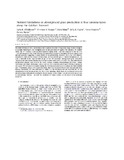| dc.contributor.author | O'Halloran, L. | |
| dc.contributor.author | Shugart, H. | |
| dc.contributor.author | Wang, L. | |
| dc.contributor.author | Caylor, K. | |
| dc.contributor.author | Ringrose, S. | |
| dc.contributor.author | Kgope, B. | |
| dc.date.accessioned | 2011-05-19T13:54:15Z | |
| dc.date.available | 2011-05-19T13:54:15Z | |
| dc.date.issued | 2010-02-19 | |
| dc.identifier.citation | O'Halloran, L. et al (2010) Nutrient limitations on aboveground grass production in four savanna types along the Kalahari Transect, Journal of Arid Environments, Vol. 74, pp. 284-290 | en_US |
| dc.identifier.other | 10.1016/j.jaridenv.2009.08.012 | |
| dc.identifier.uri | http://hdl.handle.net/10311/797 | |
| dc.description.abstract | The Kalahari Transect (KT) is an International Geosphere–Biosphere Programme mega-transect designed
to examine hydrological and ecological patterns and processes throughout the savannas of southern
Africa. The KT traverses a precipitation gradient ranging from w920 mm rain/year in the north to
w260 mm rain/year in the south. Previous research shows a positive correlation between canopy cover and precipitation suggesting a water limitation on productivity. However, there has been minimal
research on other possible sources of limitations, such as soil Nitrogen (N) and/or Phosphorus (P). We
used a factorial in-situ experimental design to test for increased aboveground grass production
(measured as peak season standing stock) under elevated soil P and Pþ N levels. Four sites along the KT
precipitation gradient were used in this study: Mongu (Zambia), Pandamatenga (Botswana), Ghanzi
(Botswana) and Tshane (Botswana). Soils at each site were amended with N and P fertilizers during the dry season. We extracted soil samples during the following growing season to analyze for plant available
soil P. Vegetation samples were harvested from which we measured foliar P and aboveground grass
biomass production. We saw differences in foliar P at the treatment and site level but not for the interaction between treatment and site. There were individual effects from site on biomass but not for any interactions with nutrient treatments. Despite higher levels of foliar P, we did not detect an increase in aboveground biomass. This may be explained by luxury uptake or allocation to below ground resources. | en_US |
| dc.language.iso | en | en_US |
| dc.publisher | Elsevier | en_US |
| dc.subject | Kalahari | en_US |
| dc.subject | Phosphorous | en_US |
| dc.subject | Precipitation | en_US |
| dc.subject | Savanna | en_US |
| dc.subject.lcsh | Grass biomass | en_US |
| dc.title | Nutrient limitations on aboveground grass production in four savanna types along the Kalahari Transect | en_US |
| dc.type | Published Article | en_US |
| dc.link | http://www.sciencedirect.com/science?_ob=ArticleURL&_udi=B6WH9-4X8BP9B-2&_user=778200&_coverDate=02%2F28%2F2010&_rdoc=1&_fmt=high&_orig=search&_origin=search&_sort=d&_docanchor=&view=c&_searchStrId=1523930823&_rerunOrigin=google&_acct=C000043160&_version=1&_urlVersion=0&_userid=778200&md5=e1dd4960d1efa8d50052d71c2421a032&searchtype=a | en_US |

